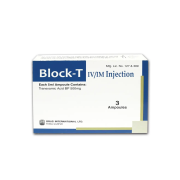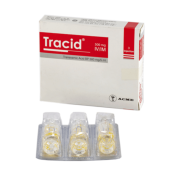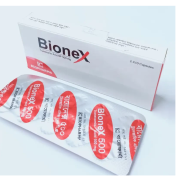Hemostop Capsule
Tranexamic Acid
Indications
In medicine: Prophylaxis and therapy of hemophtoes, digestive hemorrhages, hemorrhagic syndromes in leukaemia, cirrhosis and hemophilia, thrombocytopenic purpura, accidents during thrombolytic therapy and transfusion.
In surgery: Prophylaxis and antihemorrhagic therapy during operations of any type and nature and particularly in pulmonary, cardiovascular and abdominal surgery and post-operative and traumatic shock.
In urology: Prophylaxis and antihemorrhagic therapy of prostatic, vesical and renal surgery. Hematurias.
In obstetrics: Prophylaxis and therapy of post-partum and puerperium hemorrhages, hemorrhagic metrophathies, functional menometrorrhagias, idiopathic or IUD(lntra uterine Device) induced menorrhagias, primitive hyperfibrinolysis (abruptio placentae, premature placenta detachment) and in cervical conization.
In otorhinolaryngology: Prophylaxis and antihemorrhagic therapy during a tonsillectomy, specialist surgery generally, epistaxis.
In stomatology: Prophylaxis and antihemorrhagic therapy during maxillofacial operations, tooth extractions.
In oncology (as supportive therapy): To promote the formation of a fibrin capsule to wall off and thereby inhibit the growth of ovarian tumors. To cause regression of ascites secondary to carcinoma. To reduce bleeding during surgical interventions.
Pharmacology
This is a preparation of tranexamic acid (trans-4 aminomethyl-cyclohexanecarboxylic acid). Tranexamic acid is a substance endowed with a strong antifibrinolytic action and both in vivo and in vitro it has proved to be 10 times more active than conventional hemostatics, depending on the test. The antihemorrhagic action of tranexamic acid is essentially due to an inhibition of the plasminogen activation of both exogenous activators like streptokinase and endogenous ones like urokinase and the plasminogen tissue activator. This fact is particularly important for the clinical use of Tranexamic Acid, because it ensures an antihemorrhagic activity with an antifibrinolytic mechanism under a variety of conditions.
The acute toxicity of Tranexamic Acid is extremely low and chronic toxicity almost non-existent. Tranexamic Acid is well absorbed by oral route and the effect is already seen 15-30 minutes after administration. It is excreted mainly by renal route but more slowly than conventional hemostatics. These features make the Tranexamic Acid effect more lasting than those conventional hemostatics. Considerably lower single doses of Tranexamic Acid can thus be administered at greater intervals without the drug plasma levels dropping to inefficient levels of antifibrinolytic activity between one dose and the other.
Tranexamic Acid at therapeutic doses does not interfere with clotting processes and even a prolonged administration has not been seen to be accompanied by any tendency to thrombophilia.
Dosage & Administration
Adults-
- The usual dose: 500-1000 mg 3 times daily.
- For prophylaxis: The mean recommended daily doses are 0.5-1 gm orally, 500 mg by the parenteral (intravenous or intramuscular) route.
- For therapy of hemorrhagic manifestations: the oral dose increases to 1-3 gm given in divided doses: in cases of particular seriousness and urgency, begin by injecting an ampoule (500 mg) slowly by intravenous route and administer the necessary subsequent oral doses.
Children-
- For prophylaxis: For every kg of body weight from 5-10 mg are orally administered daily in divided doses.
- For therapeutic purposes: The oral doses are doubled (from 10 to 20 mg/kg), while the intravenous and intramuscular treatment is begun with 10 mg/kg (=0.5 ml every 5 kg) by the slow intravenous route, continuing the oral administration up to the required dose. Where it is more convenient (e.g. in small babies) the ampoules, diluted in a little sweetened water, maybe orally administered instead of the Capsules.
Elderly patients: No reduction in dosage is necessary unless there is evidence of renal failure.
* চিকিৎসকের পরামর্শ মোতাবেক ঔষধ সেবন করুন‘
Interaction
Hemostop is a synthetic Amino Acid that is incompatible with solutions containing penicillins (eg: Benzyl penicillin). Thrombolytic drugs like Streptokinase & Urokinase antagonise the antifibrinolytic action of Hemostop. The potential for thrombus formation may be increased by concomitant administration of estrogen containing drugs, like oral contraceptives. Direct admixture of Hemostop with whole blood should be avoided during Transfusion.
Contraindications
Known individual hypersensitivity to the product. Thromboembolic disease, arterial and venous thrombosis, endocavitary hemorrhages, serious kidney failure.
Side Effects
- Hemostop is generally well tolerated; there may be infrequent cases of sense of fatigue, conjunctival irritation, nasal blockage, itching, skin reddening, exanthems.
- After oral administration there may be sign of nausea, diarrhea, gastric pyrosis.
- There are rare cases of postural hypotension.
- In the case of hypersensitivity to Hemostop, avoid or suspend treatment and start a suitable therapy.
Pregnancy & Lactation
Since the transplacental passage of the drug and its possible effects on the fetus are unknown, Tranexamic Acid should not be administered during known and presumed pregnancy. Tranexamic Acid passes into breast milk to a concentration of approximately one hundredth of the concentration in the maternal blood. An antifibrinolytic effect in the infant is unlikely.
Precautions & Warnings
- Hemostop should be used in cases where there is hyperfibrinolysis. The prophylactic treatment must begin 24 hours before the operation and continue until 3-4 days after it.
- The therapy of hemorrhages must be prolonged for at least 24 hours after manifestations have disappeared.
- In hematuria, especially when this is not accompanied by any other hemorrhagic manifestations, reduce the doses to prevent formation of clots in the urinary tract.
- Hemostop must not be used in serious renal insufficiency or anuric syndromes and must only be used with caution in less serious renal dysfunctions.
- The administration of product requires particular care in cardiopathic and hepatopathic subjects.
Therapeutic Class
Anti-fibrinolytic drugs, Haemostatic drugs
Storage Conditions
Store in a dry place at 15-30°C, away from light and keep out of children’s reach.





